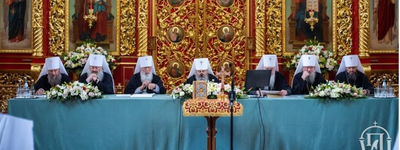April: About the Resistance to Material

Those who until the last moment though that no head of the Ukrainian state would want to become a Little Russian governor, dare cut the branch on which he sits, and divide the country, but would want to become the president of all Ukraine, cowered…
For now, truly, if not everything, then a lot is possible that yesterday still seemed unthinkable: for example, passing legislation that buries the Ukrainian model of church-state relations with its equality of religious organizations before the law and indiscrimination against religious minorities. Now it is even possible for the resuscitation and “perfection” of once rejected bills that absorb a lot of these shameful novels that celebrated legislation about the freedom of conscience of the post-Soviet space and which still have somehow passed over Ukraine. The attack on “improper” churches is also entirely possible, along with the unexpected steps regarding the “proper” churches, especially if Moscow friendly asks for these steps. In April Russia again confirmed that in the 21st century symbols play a role no less significant than in past “unpragmatic” times. Russia is fighting, suffering, and paying billions for these symbols. However, the symbols are being converted into things completely perceptible – into national unity, pride for one’s Fatherland, and unconditional readiness to defend it. In Ukraine, in addition to Sebastopol and the fleet, Russia has many painful points, symbols, that are perceived in Russia as “alls of ours” – the Kyivan baptismal font, let’s say, church unity…
From the government, in short, we can expect everything, and a lot, we recognize, depends on it. A great deal, but not everything. And the recent history is the best, simply self-evident, example. We remember that all – all with no exceptions – “national democracy” countries after WWII set out to realize policies regarding religion and the church in a completely Lenin-Stalin way. Regimes confiscated church property, imprisoned clergy, closed church schools, incited hierarchs against each other, and terrorized the laity. They did not stop before the arrest of the primate of the Catholic Church in Poland, the commanding and boundlessly authoritative Cardinal Stefan Wyszynski; attempted to break away the Catholic Church in Czech Republic from the Apostolic Capital; planted many Stasi agents in the German Church; led a shameless attack on the position of Orthodox churches in Bulgaria and Romania; and so forth. But the results that the pro-communist governments hoped to achieve through their policies “of solving the religious question once and for all” showed striking differences. The Albanian dictator Enver Hoxha, for example, announced in 1967 that all almost all two thousand mosques, churches, and prayer houses of the country are closing and that Albania is to become the first atheist country in the world. From then on a prison sentence was easy to receive from a dyed egg and from crossing oneself, and from not eating pork. And in the very same year in neighboring Yugoslavia the number of Bibles published exceeded the number of classical works of Marxism-Leninism! And when in the Soviet Union for crosses worn around the neck students were expelled from the Komsomol (with all the consequences that accompany such an expulsion), in Poland ever year close to 2,000,000 pilgrims visited Cz?stochowa . The Polish church rigidly opposed the government in questions that could not have even been subjects of any discussions between the churches and governments in other communist countries, and Cardinal Wyszynski and K. Wojtyla firmly stand against the constitutional additions about “indissoluble brotherly ties with the Soviet Union” and about the “leading and directing role of the Polish United Worker’s Party.”
So what’s the deal? The deal is in the power of resistance, which on its path to uprooting religion met the communist regimes in various countries. And even in the middle of one and the same country. Already many times I have used this eloquent example: during the Khrushchev anti-religion campaign, the leadership of the UkrSSR received “rozverstka” (food apportionment) to close half of the Orthodox churches in the republic. And the task was almost managed. But as it was met by fearless resistance, it was able to close in the Ternopil region a little more than a third of the churches, in Bukovyna – a quarter, in Transcarpathia – only every sixth. “Exact numbers” had to be closed: 70% of churches in Crimea, 71% in the Odesa region, 85% in the Dnipropetrovsk Oblast, and 91% in the Zaporizhia Oblast.
Communist leaders liked to consider people “raw material” from which they could create a “new person.” We can say that along with all the greed and shamelessness of the regimes, which, according to Mykola Berdyaiev, “themselves wanted to be the church,” they in the end progressed in their aspiration to replace the traditional religiosity with a secular cult so far as this “material” could allow. The “material” did not lose its strength to protest in the most deafening, “shooting” years and this is worth remembering by those who are ready today to not face despair but also, as they say, to face the bullet!
The key question: Why did the anti-church bacchanalia meet resistance that forced the regime to stop and begin long and exhausting sieges in some countries? And why did it not meet such protest in other countries? Why, for example, did Romanian priests take oaths under Ceau?escu and swear to help him in everything, while Lithuanian priests declared to Brezhnev that they would not carry out the Soviet anti-evangelical legislation?
Because in various societies formed various, sometimes cardinal distinctions in the religious cultures. These cultures saturated at various depths of the national thickness, formed various models of religious attitude, various understandings of the importance of religion and religious institutes in the individual life of the nation, various notions about what and how much belongs to the Cesar, and what is exclusively and exceptionally God’s. How the depths, notions, and understandings are revealed, a large, if not the determining, factor depends on the role played by one or another religious institute in the process of forming the nation. If we don’t take this into account, then we will never understand why Croatians are so devoted to the Catholic Church and why their neighbors the Slovenians treat this very same church rather distantly; why are the churches in Slovakia overflowing but half-empty nearby in Czech Republic, a people who were once called to renounce the “Habsburg Catholicism” in the name of the Czech Republic by their celebrated President Tomas Masaryk.
Certainly, to play a special role in the formation of a nation, the church should end up in the “appropriate time and appropriate place.” Having heterodox enslavers, being able to lead against them the national resurgence, not to depend on the state (often not having “one’s” state), clergy – to be the most educated stratum (often the only educated stratum of the conscious nation). However, the special role is not played without the will, intellect, aspiration, and actions of specific people. Those like, let’s say, the Ukrainian Metropolitan Andrey Sheptytsky, the first president of the Republic of Cyprus Archbishop Makarios ІІІ, the Hungarian Cardinal Jozsef Mindszenty, or the Polish priest Jerzy Popieluszko.
An unfriendly government can prohibit the church from opening general education schools, not return confiscated church property, not decorate its hierarchs with orders, and not place them near itself in presidium. But it cannot have an influence on the liturgical life, on the quality of the church realizing its essential mission in the world. In other words, a special role of the church is being played here and now because the nation is a daily, as said Ernest Renan, plebiscite. This is a daily and truly strained contemplation about who we are, where and with whom are we going, how we differ from others, and what from our past do we take to the future, and what do we keep in the past.
The church takes part in this plebiscite through the Good News and benefaction, through catechism and evangelicalism, through cultural study work, steady adherence to the church’s teaching and widening the horizons beyond the boundaries of the common human thought. It carries in this process that which only it can carry, and no one else. And this is also resistance to the “material,” resistance to the lack of faith, indifference, everything wrong and unjust.










